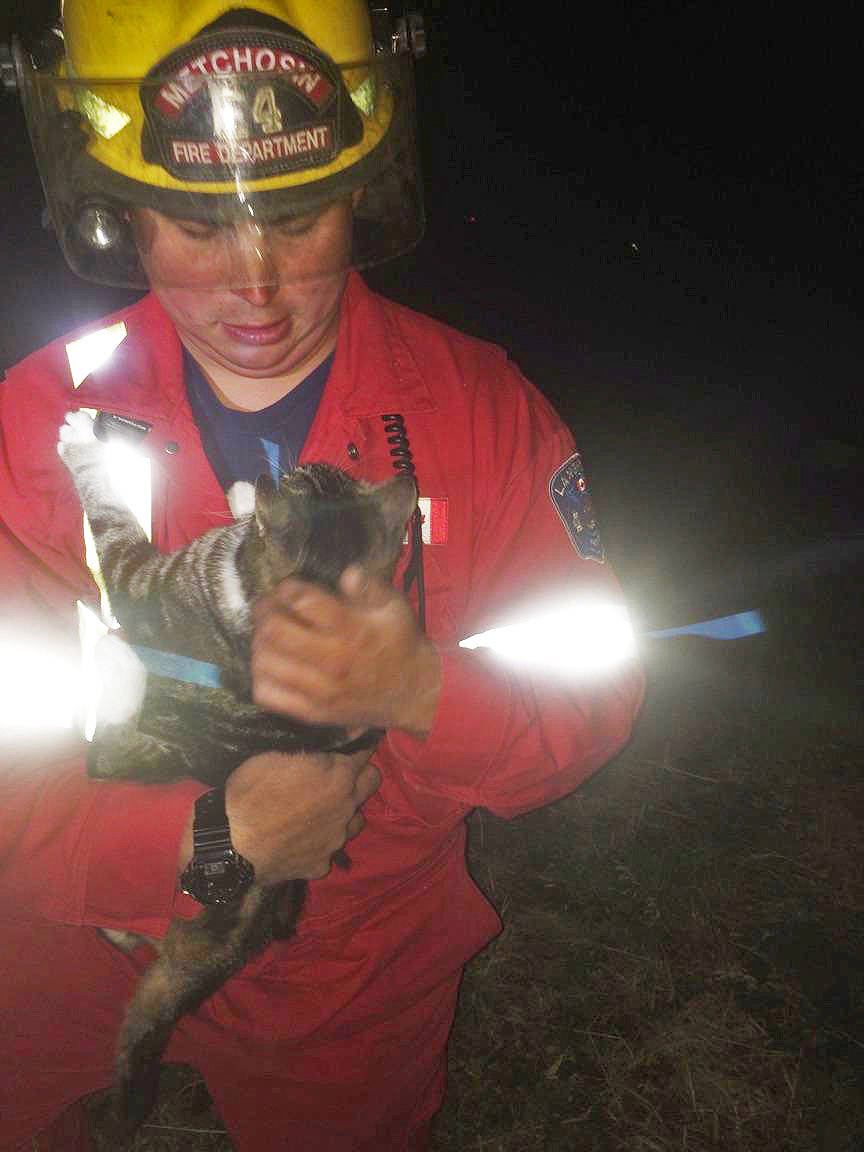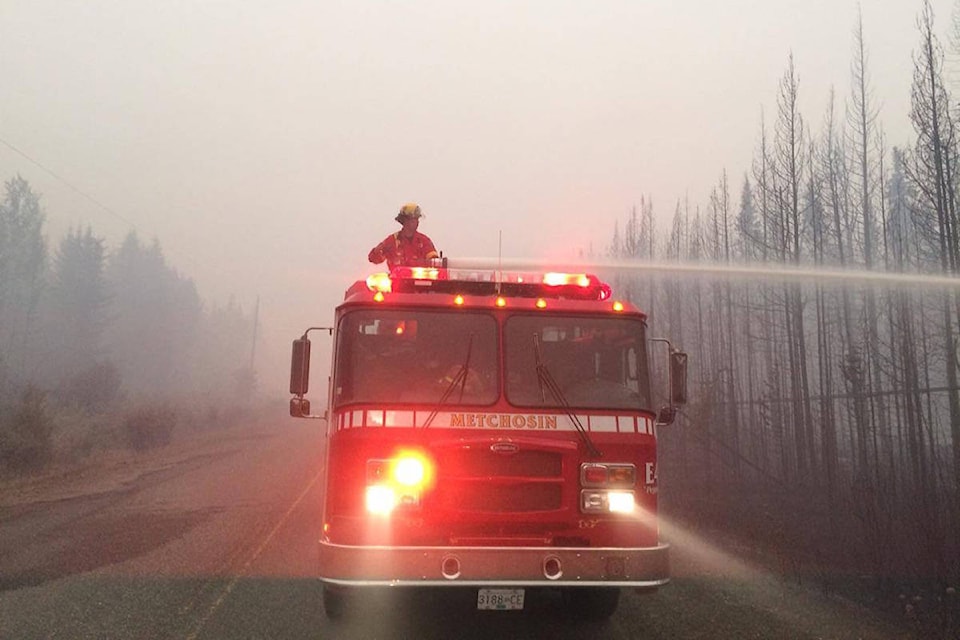The bonds between colleagues often extends beyond borders.
“The moment we started watching [the fires] on the news … I started getting calls from firefighters,” said Langford Fire Chief Chris Aubrey. “That’s what they do, they want to help … [and] it’s not just our department, it’s all departments.”
Volunteer firefighter Adam Kachanoski was the first from Langford to be deployed and recently returned from the Interior. He was part of the joint crew sent by the Langford, Metchosin and Sooke departments.
“It was important for me to go because I’m trained and I have wildfire experience,” he said. Two years ago Kachanoski worked as a contract firefighter up north but the fires in the Interior were different. “We weren’t really fighting a forest fire, we were protecting structures,” he added.
A third rotation of firefighters was dispatched last Thursday, although they were originally told the team wouldn’t be needed. But by early afternoon Aubrey noted that had changed and the firefighters were on the 9 p.m. ferry. Local crews are expected to be in the Interior for at least another two weeks.
“The situation was the most critical when Adam deployed,” Aubrey said, adding they weren’t really sure what to send the first crew with for the eight-day rotation, other than a sleeping bag and their personal gear.
But that didn’t seem to bother Kachanoski, who was prepared to sleep on the floor of the hall or the back of a truck if he had to. “We’re pretty used to getting up and going,” he said, remembering that first call was a bit surreal.
At roughly 4:45 p.m. the team was told they’d be shipping out that night and scrambled to catch the 9 p.m. ferry to Tsawwassen. Once they got off the ferry they drove all night to Cache Creek were crews were being staged before being assigned to areas in need.
While it’s a drive Kachanoski has made many times before, this was different. “This time it was smoky and the road was closed so we were the only people on it,” he said. “It was really creepy.”
The team arrived in Cache Creek at around 5 a.m. Friday morning. After a quick nap they were assigned to 150 Mile House and headed out. Once they arrived, they were greeted by the fire chief and put to work. “We pulled the short straw and got the night shift,” Kachanoski noted.
So they shifted gears again and headed off to do what they do best – fight fires. While 150 Mile House isn’t a big community with a population of roughly 1,100, there are however, a number of big properties. The team was tasked with patrolling the area and extinguishing any spot fires that flared up due to embers blowing from the main fires or from hot spots.
“That first day we were just driving, looking around for fires and we knocked down a fair bit,” he noted.
The local department has roughly 30 firefighters, which includes volunteers, auxiliary and reserve members. “It’s not a big department, but they sure came across as they were … It was impressive to see that small community pull together and pull off something that would have been tough for anyone,” he said. “Our experience was as positive as it was because of the hospitality.”
Firefighters’ significant others banned together to make breakfast and lunch for the roughly 80 people stationed at the hall, which was built to accommodate roughly two trucks but instead had about 20. “They were cooking whatever they could with the resources that were there … When Williams Lake shut down they just sort of stocked up and did what they could,” Kachanoski said.
A woman who owns a catering company in Williams Lake also provided dinner. Unfortunately, Kachanoski noted, her place in Williams Lake burned to the ground.
“We all just kind of took care of each other,” Kachanoski noted, with firefighters doing what they could to help with meal prep. A local RV dealer even brought his rental vehicles to the fire hall for crews to sleep in and when that wasn’t enough, he brought some brand new models to house the influx of firefighters.
Kachanoski’s second day in the community was the Saturday that Williams Lake was evacuated. He noted it was originally clear in the morning but by 4 p.m. there was a huge smoke plume looming over them in the sky. “It got pretty bad, they pulled everyone off the fire line at around 5 p.m.,” he said. Since there was such an increase in danger for the crews, they were pulled back to a safe zone until the fire could be re-assessed. “We just patrolled the town to make sure no structures were burning.”
While they were out, a father stopped the truck. His son was going into anaphylactic shock due to a wasp sting and the team was able to stabilize the boy until the paramedics and the air ambulance could get him to a hospital.
But day three, or the Sunday, was the busiest. “We put out a lot of fire that day … We dropped around 10,000 gallons of water,” Kachanoski said. And with a truck that holds 1,000 gallons and a water source that was more than a 30 minute drive away, that meant crews were hustling to make sure they had enough water supplies to keep on top of the flare ups.
They found themselves in a similar situation for days four and five.
Day six, however, was the night they met Peaches. The team was patrolling a fire guard behind one subdivision in particularly that was experiencing a number of fires. One large spot fire ignited and the crew was busy trying to knock down the blaze.
“As I’m fighting the fire, this cat jumped up on me,” Kachanoski said. He put the cat down and continued to battle the blaze but the cat kept jumping into his arms. She patiently waited for the team to finish and followed them. So they decided to take her back to the hall with them and she was given the name “Peaches” after a joke that was going around at the time.
“There was definitely a bond between Peaches and Adam,” Aubrey noted.
It turns out that Peaches was a stray that was up for adoption before the fires broke out and once Kachanoski is back from some much deserved time off, he’ll have first refusal to adopt her and her sister, who crews named Sparky.
Peaches and Sparky weren’t the only animals firefighters were tasked with caring for. Kachanoski said there was a crew solely in charge of making sure any animals left behind were cared for.
“It’s just a huge a collective effort, British Columbians of all walks of life are coming together,” Aubrey said.
As for working with an unfamiliar team and truck, Kachanoski noted, “it doesn’t matter what the name is on the side of the truck, you’re all firefighters … We were able to function like we’ve been working together for a long time.”
And that bond is something the West Shore firefighters have brought home with them.




